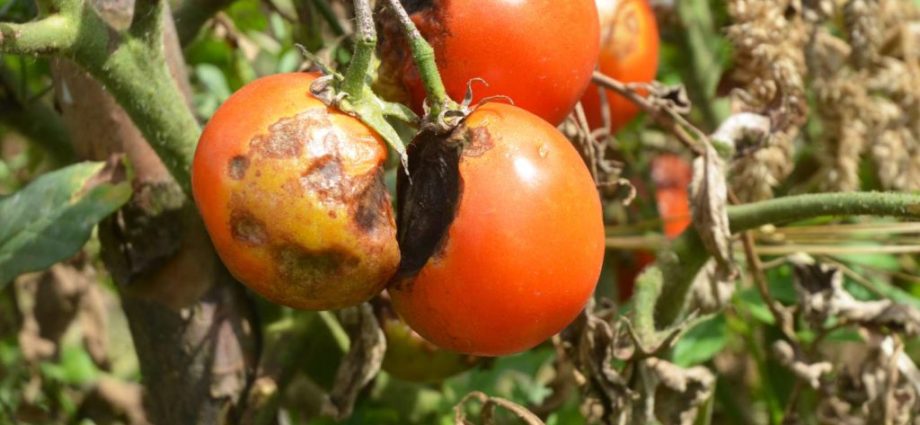Contents
Phytophthora is a fungus that can infect potatoes, peppers, eggplants and, of course, tomatoes, causing a disease such as late blight. Phytophthora spores can move through the air with a stream of wind or be contained in the soil. In the “sleeping” state, they fall on the leaves of plants and rest there until favorable conditions occur, after which they actively multiply, causing harm to tomatoes.

More often you can find phytophthora on tomatoes in the open field in autumn, during prolonged cold snaps or after heavy rains. Fungi develop very quickly, infection of tomatoes occurs in a few hours. That is why you need to use and know preventive measures to combat the disease. The appearance of external signs of phytophthora infection on the leaves and trunks of tomatoes indicates the active stage of reproduction of fungi. At this stage, various chemicals and improvised means can be used to save tomatoes.
Reasons for infection
Strong, healthy tomatoes in conditions with optimal temperature and humidity, regular, moderately plentiful watering have sufficient immunity to resist late blight. And the fungi themselves in such conditions cannot reproduce. Their active division and distribution occurs in an environment with high humidity and relatively low temperature. Such conditions are typical for the autumn period, but can overtake the gardener in the summer.
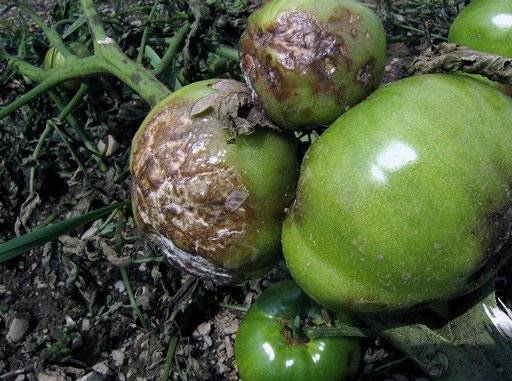
The following circumstances can provoke the division of phytophthora fungi:
- weather conditions with prolonged rains and cooling;
- frequent and sudden changes in temperature;
- lack of micronutrients in the soil;
- frequent, abundant watering;
- high concentration of nitrogen in the soil;
- growing tomatoes in wetlands;
- growing tomatoes in close proximity to other nightshade crops;
- dense planting of tomatoes without observing the recommended distances;
- growing tomatoes on soils of neutral acidity or a high concentration of lime in the soil.
Of course, growing tomatoes in open ground, the gardener cannot influence the weather conditions in any way, but it is still possible to provide some protection from phytophthora for tomatoes by choosing sunny, calm plots of land for growing, groundwater on which are located far from the surface. The distance between the bushes when planting seedlings should be sufficient to ensure normal air circulation. Condensed plantings contribute to the rapid spread of a fungal disease through contact between leaves and tomato fruits. Particular attention should be paid to the choice of “neighbors” for tomatoes: peppers, potatoes or eggplants should not be planted close to tomatoes, it is better if it is, for example, garlic. In addition to the above growing conditions, there are other preventive methods for protecting tomatoes from late blight.
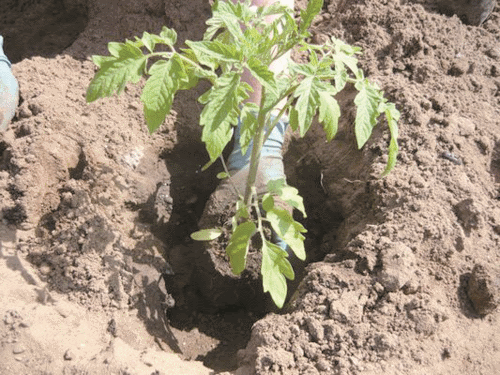
Prevention of late blight
Some tomato seed growers offer phytophthora-resistant varieties, but don’t rely on this trick. There are no varieties with absolute protection against phytophthora. When purchasing seeds, you need to take care of the protection of tomatoes and the future harvest on your own at the stage of sowing seeds for seedlings:
- Phytophthora spores can be destroyed from the surface of the grains by soaking them in a special antifungal solution, for example, a solution of the Phytodoctor or Fitosporin preparation;
- late blight spores can also be contained in the soil for growing seedlings, therefore, before sowing seeds, it must be disinfected with boiling water. Heating in the oven or over an open fire is also effective;
- containers reused for growing seedlings must be treated with a solution of copper sulphate.
Subject to such simple growing rules, tomato seedlings are reliably protected from the disease, however, when planted in open ground, the likelihood of infection with phytophthora fungi increases, which means that additional measures of preventive protection of tomatoes must be resorted to.

Methods of protection in open ground
Before planting tomatoes in the soil, the holes should be shed with a solution of boiling water with the addition of potassium permanganate. Prevention of late blight on tomatoes in the open field may consist in treating the bushes with special biological products or folk remedies. Among the biological products, the most effective are “Zircon” and “Fitosporin”. These biological products should be diluted with water in accordance with the instructions, for example, for preventive spraying of tomatoes, add 2-3 tablespoons of Fitosporin to a bucket of water. This volume should be enough to process tomatoes per 100m2.

Experienced gardeners often resort to folk methods of protecting tomatoes from late blight:
- Spraying with saline. You can prepare it by adding 1 cup of table salt to a bucket of water. After mixing, the tomatoes are sprayed with a solution, as a result of which the salt covers the leaves of the tomatoes with a dense film, preventing phytophthora spores from penetrating their surface.
- Spraying with ash infusion. Ash is not only a microelement fertilizer for tomatoes, but also an effective means of protection against late blight. You can prepare an ash solution by adding 5 liters of this substance to a bucket of water. After mixing, the agent is infused for 3 days, then 40-50 g of grated laundry soap is added to it. Ash, like saline, protects tomatoes by covering the leaves of plants with a film.
- Treatment with fermented kefir or whey. These products are diluted with water in a ratio of 1:9 and used for spraying tomatoes.
In addition to the above methods for open ground, there are other ways to protect tomatoes based on the use of garlic, copper wire, and iodine. An example of the use of folk remedies for late blight on tomatoes can be seen in the video:
However, it should be understood that such products can protect tomatoes from late blight, but not cure an already damaged plant. Therefore, they should be used regularly for prevention 1 time in 10 days.
Tomato Care Rules
You can reduce the risks of infection of tomatoes with phytophthora if you follow some rules for growing and caring for plants:
- It is impossible to grow tomatoes two seasons in a row in the same place. In the place where solanaceous crops used to grow, it is possible to grow tomatoes only after 2-3 years. It is better to plant tomatoes in places where cauliflower, beets, carrots, onions, and cucumbers used to grow.
- It is necessary to water the tomatoes early in the morning or after sunset exclusively at the root, since the accumulation of water in the axils of the plant provokes the development of phytophthora.
- On days with high humidity, it is recommended to refrain from watering, after only loosening the soil. It is worth noting that mulching, which allows you to retain moisture in the soil, is also considered a preventive measure in the fight against late blight.
- Healthy tomatoes have a certain immunity to late blight, so you need to regularly monitor their balanced diet, fertilize with phosphorus and potassium. The use of fresh manure and other fertilizers with a high nitrogen content for tomatoes is undesirable.
- By correctly forming bushes of tomatoes, carrying out pinching, you can avoid dense plantings and improve air circulation between the fruits and leaves of tomatoes.
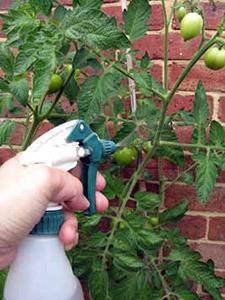

Thus, by observing the simple rules for caring for tomatoes and periodically carrying out their preventive treatment with biological products or folk remedies, you can reliably protect plants and successfully deal with late blight even in favorable weather conditions for its development.
Signs of late blight
Many gardeners know the signs of phytophthora damage, however, unfortunately, they are the visible result of the already active activity of fungi. In the early stages of infection, it is almost impossible to detect signs of phytophthora development on tomatoes.
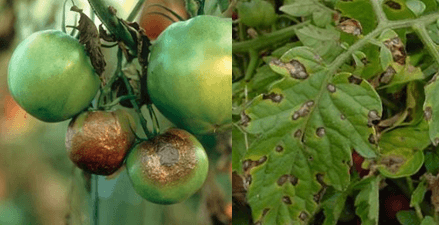

Late blight symptoms appear a few days after infection. So, you can understand that tomatoes are infected by the following signs:
- Small spots appear on the inside of the leaf. Over time, they appear through the entire thickness of the leaf plate and acquire a dark, brown hue. As phytophthora develops, the leaves dry out and fall off;
- Dark, and then black spots appear on the main trunk, tomato shoots. The affected areas begin to dry out;
- Tomato ovaries turn black and fall off;
- Dark dots appear on the fruits, which subsequently turn into weeping rotten spots.
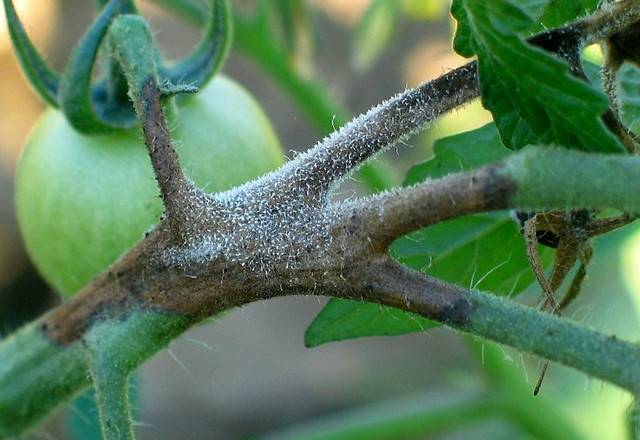

An attentive owner should regularly inspect tomato plantings in order to detect and eliminate the problem in the early stages. At the same time, it is worth paying attention to the factors provoking the disease: cold rains, sudden changes in weather conditions, and others. It is after such changes that we should expect the development of phytophthora, and, therefore, it will be useful to treat the bushes with preventive protection.
Treatment of tomatoes from late blight
If preventive measures to protect tomatoes from phytophthora were not carried out or did not give the expected result and signs of the disease appeared on the leaves, trunks of the plant, then it is necessary to start treating the plants as soon as possible. To do this, you can use special chemicals or some improvised substances.
Chemicals
There are various chemical preparations from phytophthora with high efficiency. Among them, Infinito, Metalaxil, Ecopin, Ditan M45 and some others should be singled out. These substances are diluted in water in accordance with the instructions and used to spray tomatoes.
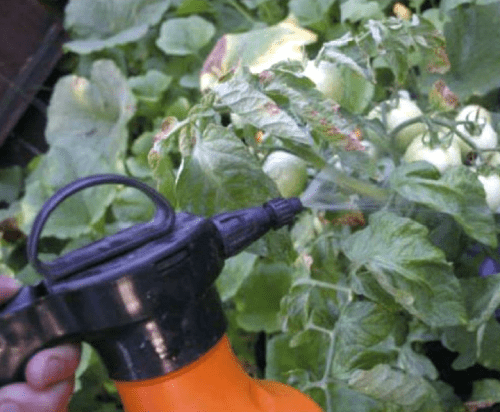

It is worth noting that all these substances are dangerous to human health, which is why it is preferable to use them until the fruit ripens. If the chemicals were used during the ripening of vegetables, then the fruits should be eaten no earlier than 3 weeks later. During this time, the drugs stop their activity.
Improvised means of protection
In the fight against late blight, especially during fruit ripening, it is recommended to use folk, but effective methods of treating tomatoes:
- Antifungal and antiviral medicines, such as “Metronidazole” and “Trichopol” have long been used to combat late blight. Tablets are easy to find in any pharmacy, their cost is affordable. Prepare a solution of these antibiotics by dissolving 20 tablets in 10 liters of water.
- Copper sulfate can be used as a prophylactic remedy and for the treatment of tomatoes from phytophthora. It is used in the form of an aqueous solution by adding 2 tablespoons of the substance to a bucket of water. Such a tool is effective, but it is often impossible to use it.
- Based on boric acid you can prepare a remedy for the treatment of tomatoes from phytophthora. The substance is diluted in water in the ratio of 1 teaspoon per bucket of water.
- Spraying infected tomatoes 1% potassium chloride solution can defeat the disease. You can find the substance in a pharmacy.


The above methods of treating tomatoes are quite effective. However, it is necessary to use chemicals with extreme caution, after such treatment, the fruits should be “kept” on the bush for at least 3 weeks and washed thoroughly before use. Improvised means do not pose a danger to humans, but to achieve high efficiency they must be used several times with an interval of 7-10 days.
Actions with damaged tomatoes
When the treatment of late blight-infected tomatoes has been carried out, care must be taken to preserve the still immature tomatoes and the already ripening crop:
- Remove the affected tomato leaves and burn;
- Ripe but blackened tomatoes will likely need to be discarded or cut off the damaged parts of the fruit and use “clean” tomatoes for canning;
- Unripe, but damaged by late blight tomatoes, should be removed from the bush and warmed up in water with a temperature of 600C. To do this, pour a heated liquid into a basin or bucket and lower the tomatoes into it. As it cools, the water is changed to warm. After complete warming, the phytophthora fungus in the fruits dies, which means that they can be laid in a dark place for ripening without fear of rot development. Also, unripe tomatoes, after trimming the damaged parts, can be used for canning;
- It is impossible to lay tops damaged by phytophthora on compost, this will contribute to the preservation of the fungus and infection of plants next year;
- It is possible to collect seeds from infected tomatoes for sowing the next year only if they are treated with antifungal drugs before sowing in the ground.
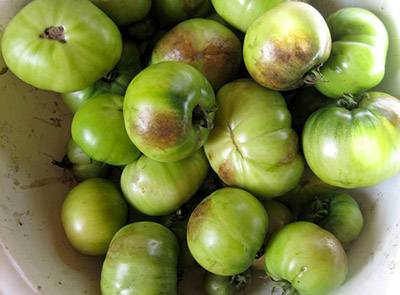

To summarize
Thus, it is better to fight phytophthora at “far approaches”, treating seeds, soil before sowing a crop, properly caring for plants planted in open ground and taking regular preventive measures to protect plants from this disease. When infected, it is very important to detect the problem in a timely manner and remove damaged leaves and fruits of tomatoes, treat the bushes with special substances. Vegetables “hit” by phytophthora should not be thrown away immediately, since with proper subsequent processing they can be partially eaten in canned and even fresh form. In general, the fight against late blight requires attention and knowledge that will help defeat the “enemy”.










